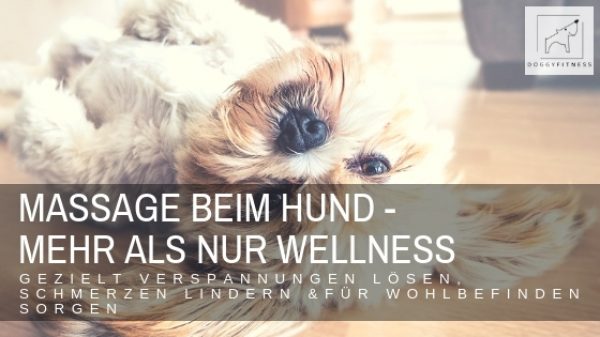The emergence of massage in dogs
Massage for dogs is not an invention of modern times. In general, massage has been known for its healing and pain-relieving effects for many thousands of years. More than 4000 years ago, the first massage techniques were described. Massages are believed to have originated in the Asian and African regions. Thus, it is one of the oldest treatment techniques of mankind. The techniques of classical massage were transferred to the anatomy of the dog. Everyone knows how pleasant and pain-relieving a relaxing massage can be. Dogs find them equally pleasant.
When is a massage applied to the dog?
Massage is an important component in physiotherapy. It is used to relax tense and hardened muscles and to relieve pain. In case of neurological diseases we stimulate slack muscles with massage. It is also frequently used for diseases of the musculoskeletal system. With massage we strengthen the awareness of the body and take psychological stress. Of course, you can use the massage even if your dog is healthy. It is perfect as a wellness treatment and to strengthen the bond with your dog. Sporting dogs can also be warmed up and relaxed by massages before and after training or competition.
Massage also supports the success of the active exercises you perform with your dog. If painless movements are possible with loose muscles, your dog will be more motivated to cooperate than if the muscles are tense. The performance of the sporting dog is increased by warm and loose muscles. You can do full body massages, but also partial massages such as just the back or just one leg.
When is massage off limits for your dog?
Massage should not be performed in case of inflammation, pregnancy, tumors and fever. It is also off-limits for heart disease, infectious diseases, fresh injury and bleeding tendencies.
What happens during the massage?
You treat the skin, subcutaneous tissue and muscles with various grip techniques, such as stroking, circling, kneading, shaking and rolling. The blood flow to the muscles and the temperature in the tissues is increased. Pain substances are removed. Tensions are loosened, pain is relieved, nerves are stimulated. Massage also has an effect on your dog’s metabolism and circulation. Breathing, heartbeat, digestion are influenced. Your dog relaxes physically and mentally.
Feel-good atmosphere is important
Pick a time for the massage that falls within your dog’s resting period. Your dog should always be loosened up before the massage and not have a full stomach. A massage should take place in a relaxed, calm atmosphere, you yourself should be relaxed and take enough time. The room temperature and lighting should be comfortable. TV, telephone and other distracting factors are taboo. Just as we ourselves would like a relaxing massage. Your dog should lie softly and your position should also be comfortable.
How to find out if your dog is tense
You should get an idea of how your dog is doing before any massage. Gently feel the muscles and find out where there is tension and hardening. Always proceed here on both sides to perceive differences in the body halves and runs. Do you feel any heating or swelling? Is the musculature on the two halves of the body different or hardened? This takes a little practice and sometimes it helps to close your eyes. Concentrate fully on what the fingers sense and “see”. Your hands must be loose and relaxed for this.
For a little help on how tight muscles feel, I recommend the following:
Rest your forearm loosely and relaxed on the table. Then raise your hand. Now when you feel the muscles of your forearm, feel how tense muscles feel. You can also check the pressure of each grip this way, if you are unsure how much pressure is right for the massage. Of course, you always have to take into account what your dog finds comfortable.
Massage for dogs – what you should consider
For a full body massage, you usually start at the back, then massage the back. Finally, it’s the turn of the front legs. When you’ve finished massaging one side of your body, slowly let your dog stand up and then have him lay down on the other side. Turning your dog over your back can be dangerous. Gastric torsion may occur. Also, it can be uncomfortable for him. You should not bend over your dog, as dogs do not like that.
This is also important
Never massage on the bone. This is uncomfortable to painful and can lead to irritation. Always work in the direction of growth of the coat during the relaxing massage. All grips are performed slowly, evenly and gently. Always apply the massage strokes with as much pressure as necessary, but as little as possible. Always be focused with your dog. Pay close attention to his reactions. Lifting the head, panting, smacking and opening the eyes, for example, can be signs that the pressure of the grip was too high. After the massage your dog should have the opportunity to relax, drink and rest.
In my next article, I’ll explain strokes as the first massage move you can use on your dog to relieve tension and ease pain.
Would you like to learn how to massage your dog? Then discover my RelaxFIT course. Here you will learn the right massage techniques to relieve tension, muscle and joint pain in your dog.
Dieser Beitrag ist auch verfügbar auf:
Français (French)
Deutsch (German)
Español (Spanish)
















